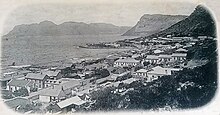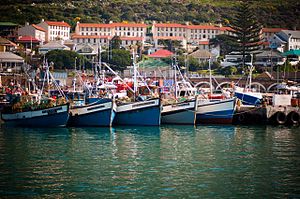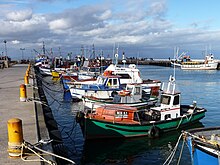Place in Western Cape, South Africa
| Kalk Bay Kalkbaai | |
|---|---|
 Kalk Bay as seen from the railway Kalk Bay as seen from the railway | |
   | |
| Coordinates: 34°07′40″S 18°26′54″E / 34.12778°S 18.44833°E / -34.12778; 18.44833 | |
| Country | South Africa |
| Province | Western Cape |
| Municipality | City of Cape Town |
| Main Place | Cape Town |
| Government | |
| • Councillor | Aimee Kuhl (DA) |
| Area | |
| • Total | 0.32 km (0.12 sq mi) |
| Population | |
| • Total | 700 |
| • Density | 2,200/km (5,700/sq mi) |
| Racial makeup (2011) | |
| • Black African | 8.1% |
| • Coloured | 32.3% |
| • Indian/Asian | 0.1% |
| • White | 54.6% |
| • Other | 4.9% |
| First languages (2011) | |
| • English | 86.2% |
| • Afrikaans | 10.3% |
| • Other | 3.5% |
| Time zone | UTC+2 (SAST) |
| Postal code (street) | 7975 |
| PO box | 7990 |
Kalk Bay (Afrikaans: Kalkbaai) is a fishing village and suburb of Cape Town. It lies on the west coast of False Bay. Much of the town is built on the slopes of mountains which border the sea, with peaks of Table Mountain Sandstone forming valleys. The railway from Cape Town to Simon's Town passes through Kalk Bay, which has one station near the harbour.
Kalk Bay is adjacent to the historically connected suburb of St James, with the division between the two being largely formal. They share the Kalk Bay & St. James Ratepayers and Residents Association, which manages a heritage committee and co-operates with the government on matters of safety and conservation.
In 2018 Forbes Magazine voted the neighborhood one of the "coolest in the world".
History

Early history
It is challenging to separate the history of the Kalk Bay area from the wider history of False Bay. It is likely that the Kalk Bay area was inhabited by Khoekhoe for thousands of years before white settlement, much like the rest of False Bay. Middens found under cliff overhangs in the mountains on which Kalk Bay sits indicate they may have been used for shelter.
The village of Kalk Bay was likely established in the 17th century. The first written mention of the name Kalk Bay came from Simon van der Stel in 1687. Its name is derived from the Dutch and Afrikaans name Kalkbaai, translating to Lime Bay. This name likely emerged from the deposits of mussel shells which were burnt by early settlers to make lime.
The early fishing population of Kalk Bay consisted primarily of slaves from the British colony of slaves brought from Bengal, Indonesia, and Ceylon. They would gain their freedom in 1807, when slavery was made illegal in the British Empire. They were also largely Muslims, leading to the construction of a mosque in 1846.

Under British rule, whaling became an important industry within Kalk Bay. It began around the start of the 19th century, and drove human settlement in Kalk Bay. By the 1870s, whale stocks were so depleted that it became a secondary activity to fishing, and by the early 20th century the whale fishery collapsed.
The population was bolstered by the arrival of Filipino fishermen in the 1850s, likely arriving from Simon's Town. The largely Catholic Filipinos are the origin of the separation between Kalk Bay and St James, which contains the only Catholic church in the area.
The railway line to St. James & Kalk Bay was opened in 1883, with construction beginning on the formal harbour walls in 1913.
Harbour
The Kalk Bay harbour is an artificial harbour constructed on the site of a natural harbour. Early fishermen in Kalk Bay launched small boats from the beach. The arrival of the railway line in 1883 jeopardized this practice, as it drastically reduced available space on the beach and disconnected it from the main road. Combined with the arrival of larger fishing vessels in False Bay, pressure mounted to construct an artificial harbour. Construction of an artificial harbour began in 1913, completing in 1918. A secondary mole began construction in 1937, finishing in 1939.
| This section needs expansion with: from source. You can help by adding to it. (May 2024) |
Attempts at dislocation

The passing of the Slums Act of 1934 called for the demolition of 'slums', and was applied with the intent of advancing segregation. Within Kalk Bay, this led to the demolition of houses in an area known as Die Land. This housing was largely inhabited by the Coloured fishing population due to its proximity to the harbour. The act did require for the construction of replacement housing, but this housing was usually segregated and built on the periphery of towns and cities.
The population of Kalk Bay fought for replacement housing to be built in the same location and succeeded, leading to the construction of a set of flats on the cleared land, colloquially known as the "Fishermen's Flats".
In 1967, Kalk Bay was proclaimed a "White Area" under Proclamation 150 of the Group Areas Act. This led to significant protest within Kalk Bay, and a historically unique about-face in which the majority of Kalk Bay's non-White population was allowed to remain for 15 years. This 15 year deadline was never acted upon, meaning that most of the population remained. Roughly a quarter of families were evicted.
Tourism

The historically dominant fishing industry of Kalk Bay has largely been replaced by tourism, driven by a few notable attractions. The harbour still hosts an active fishing industry, however it has also become a popular tourist attraction. It features multiple seafood restaurants and a fresh fish market. It is also known for its population of brown fur seals.
Kalk Bay has a reef with a break known as "Kalk Bay Reef". It is known for heavy barrels and the associated shallow reef, which makes it more hazardous than most popular surf spots. It is best surfed on a big south-easterly swell or a north west wind. In smaller swells low tide makes for better barrels. The waves are often good for surfing in the winter and early spring.
Another popular activity is whale watching, as Southern right whales migrate through False Bay during a few months of the year.
In addition, the mountains above Kalk Bay contains multiple hikes, being Echo Valley and Trappieskop (which translates from Afrikaans as steps hill). These are accessible from Boyes Drive, which runs across the mountain above Kalk Bay. These trails can be used to access sandstone caves known as "Boomslang Cave" and "Ronan's Well", popular among amateur cavers for their ease of access, relative safety, and simple layouts.
These caves are of importance to speleologists because they have formed in sandstone. Large cave systems are not often found in this type of chemically nonreactive rock.
Coat of arms
Kalk Bay (including Muizenberg and St James) was a municipality from 1895 to 1913. The town council assumed a coat of arms, designed by Frank Newnes, in July 1901.
The shield was divided horizontally. The upper half was divided vertically, depicting a fishing boat (partly obscured by a small shield) and eight fleurs de lis, while the lower half depicted a bunch of grapes. A small shield displaying an arum lily was placed in the centre.
See also
References
- ^ "Sub Place Kalk Bay". Census 2011. Archived from the original on 2019-07-11. Retrieved 2019-03-22.
- Compton, J.S. (2004).The Rocks and Mountains of Cape Town. p. 24-26, 44-70. Double Storey Books, Cape Town. ISBN 1-919930-70-1.
- "Kalk Bay & St James Ratepayers". Kalk Bay & St James Ratepayers. Archived from the original on 2022-07-05. Retrieved 2023-09-11.
- "Kalk Bay named one of the 'coolest places' - Forbes". SABC News. 2018-07-22. Archived from the original on 2019-01-27. Retrieved 2020-05-01.
- Abel, Ann (22 June 2018). "The 12 Coolest Neighborhoods Around the World". Forbes. Archived from the original on 2020-06-13. Retrieved 2020-05-01.
- ^ Kirkaldy, Alan (November 1988). "The sea is in our blood" - community and craft in Kalk Bay (PDF) (MA thesis). University of Cape Town. Archived (PDF) from the original on 2022-03-21. Retrieved 2023-09-11.
- ^ "Timeline – Kalk Bay Historical Association". Archived from the original on 2023-03-22. Retrieved 2023-09-11.
- "Simon van der Stel's Day Register". Cape Archives (in Dutch). 11: 481.
- "Bulletin 1 1997". kbha.co.za. Retrieved 2024-10-14.
- Carelse, Erin (27 June 2023). "Celebrating 110 years of Kalk Bay Harbour". False Bay Echo. Archived from the original on 26 May 2024. Retrieved 26 May 2024.
- "Apartheid Legislation 1850s-1970s | South African History Online". www.sahistory.org.za. Archived from the original on 2019-04-01. Retrieved 2023-09-11.
- "1934. Slums Act - The O'Malley Archives". omalley.nelsonmandela.org. Archived from the original on 2023-09-30. Retrieved 2023-09-11.
- ^ "Kalk Bay Historical Association". Archived from the original on 2023-03-30. Retrieved 2023-09-11.
- "December Newsletter". Kalk Bay & St James Ratepayers. 2016-12-02. Archived from the original on 2024-05-26. Retrieved 2023-09-11.
- Getaway (2021-06-30). "Kalk Bay: The Happy Harbour". Getaway Magazine. Retrieved 2024-10-14.
- Master, Web (2021-12-27). "Kalk Bay Seal Finally Off the Hook, Freed from Pain • Cape of Good Hope SPCA". Cape of Good Hope SPCA. Retrieved 2024-10-14.
- "Subseries G10 - Avernas, Boomslang, White Dome Grotto, Wessels Grotto". AtoM@UCT. Archived from the original on 26 May 2024. Retrieved 11 September 2023.
- "Subseries G8 - Ronan's Well Cave. Kalk Bay. Includes drawings on positions of caves on Black Table". AtoM@UCT. Archived from the original on 26 May 2024. Retrieved 11 September 2023.
- Sharratt, Norma J.; Picker, Mike D.; Samways, Michael J. (2000). "The invertebrate fauna of the sandstone caves of the Cape Peninsula (South Africa): Patterns of endemism and conservation priorities". Biodiversity and Conservation. 9 (1): 107–143. doi:10.1023/A:1008968518058. S2CID 28508022.
- Western Cape Archives : Kalk Bay Municipal Minutes (23 July 1901).
- "GoSouth ~ South African, Credible and Current".
External links
 Kalk Bay travel guide from Wikivoyage
Kalk Bay travel guide from Wikivoyage